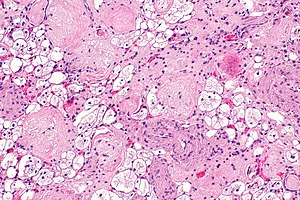Difference between revisions of "Benign clear cell clusters of the kidney"
Jump to navigation
Jump to search
| Line 40: | Line 40: | ||
*Large cells predominantly in "small" nests with: | *Large cells predominantly in "small" nests with: | ||
**Voluminous clear cytoplasm. | **Voluminous clear cytoplasm. | ||
**Small nuclei without prominent nucleoli. | **Small nuclei without prominent nucleoli ([[ISUP nucleolar grade]] 1 or 2). | ||
Notes: | Notes: | ||
*Tubules with narrow lumens may be present. | *Tubules with narrow lumens may be present. | ||
*"Small": typically less than 1.5 mm. | *"Small" nests: typically less than 1.5 mm. | ||
DDx: | DDx: | ||
Revision as of 19:30, 31 January 2021
| Benign clear cell clusters of the kidney | |
|---|---|
| Diagnosis in short | |
 Benign clear cell clusters of the kidney. H&E stain. | |
| LM DDx | chromophobe renal cell carcinoma, other clear cell tumours |
| IHC | PAX8 +ve, CK7 +ve, AMACR -ve, CD68 -ve, CD10 +ve/-ve, CD117 +ve/-ve |
| Site | kidney - see kidney tumours |
|
| |
| Clinical history | chronic renal insufficiency |
| Prevalence | very rare |
| Radiology | +/-renal mass |
| Prognosis | presumed benign based on limited data/unknown |
Benign clear cell clusters of the kidney are a rare finding that may be confused for renal cell carcinoma[1] or may represent a precursor lesion of renal cell carcinoma.[2]
General
- Associated with chronic renal insufficiency.
Microscopic
Features:
- Large cells predominantly in "small" nests with:
- Voluminous clear cytoplasm.
- Small nuclei without prominent nucleoli (ISUP nucleolar grade 1 or 2).
Notes:
- Tubules with narrow lumens may be present.
- "Small" nests: typically less than 1.5 mm.
DDx:
IHC
Features:[1]
- PAX8 +ve.
- AE1/AE3 +ve.
- CK7 +ve.
- EMA +ve.
- CD10 typically focal.
- CA IX -ve.
- vimentin -ve.
- AMACR -ve.
- CD68 -ve.
- Alpha-inhibin -ve.
- Calretinin -ve.
- Melan A -ve.
- HMB-45 -ve.
Images
See also
References
- ↑ 1.0 1.1 "Clear cell clusters in the kidney: a rare finding that should not be misdiagnosed as renal cell carcinoma". Virchows Arch. January 2021. doi:10.1007/s00428-021-03018-4. PMID 33447899.
- ↑ Ross J, He H, Lin X, Yang X, "Clear cell cluster in the kidney: Is this a precursor lesion of renal cell carcinoma?", USCAP Annual Meeting 2018, Abstrct ID# 1058.






